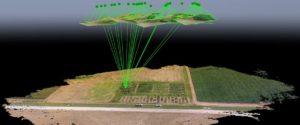USDA, 2017-2020, CO-PI, PI: Dr. Seth Murray
This project combines an emerging need in plant breeding, the development of analytical methods and software to complement high-throughput field phenotyping (HTFP) data collection technologies for plant breeding and genetics programs, with application of HTFP to the U.S.-wide maize (Zea mays L., i.e. corn). The two primary types of information of interest in using agricultural crop remote sensing and HTFP for plant breeding are plant morphology and spectral reflectance. Morphology includes height estimation and canopy surface profiling. Three-dimensional corn canopy models have been generated with UAS structure-from-motion methods and lidar, to provide plant height estimates and other biophysical parameters.
